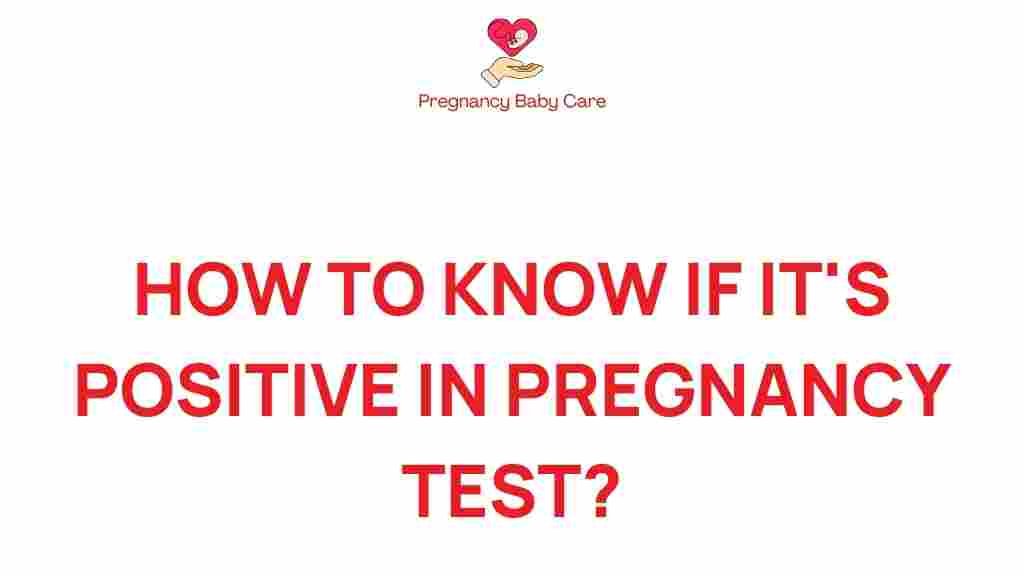Decoding the Mystery: How to Know If Your Pregnancy Test Is Positive
Taking a pregnancy test can be an emotional and nerve-wracking experience. Whether you’re eagerly hoping for a positive result or anxiously awaiting confirmation, understanding how these tests work is crucial. In this article, we’ll explore the early signs of pregnancy, the mechanics of home testing, and how to interpret the results accurately. We’ll also discuss hormone levels, conception, ovulation, and fertility, giving you a comprehensive guide to decoding your pregnancy test results.
Understanding Pregnancy Tests
Pregnancy tests work by detecting the presence of the hormone *human chorionic gonadotropin* (hCG) in your urine or blood. This hormone is produced shortly after a fertilized egg attaches to the lining of the uterus, typically around six days after conception. Here’s how you can navigate the process of taking a pregnancy test:
Step-by-Step Process for Taking a Pregnancy Test
- Select the Right Test: Choose a reliable home testing kit from a reputable brand. Look for tests that claim over 99% accuracy to ensure you have the best chance of an accurate result.
- Timing is Key: For the most reliable results, wait until the first day of your missed period. Testing too early can lead to false negatives due to low hormone levels.
- Collect Your Sample: Follow the instructions carefully. Most tests require you to urinate directly on the test stick or to collect urine in a cup and dip the test into it.
- Wait for Results: After a few minutes, check the test for lines or symbols indicating the results. Each brand may have slightly different instructions, so it’s essential to read the packaging.
Interpreting the Results
Understanding your results is critical. Here’s how to determine whether your pregnancy test is positive:
- Single Line: This typically indicates a negative result. No hCG was detected, which may mean you are not pregnant.
- Two Lines or Plus Sign: This usually indicates a positive result. The presence of hCG confirms pregnancy.
- Faint Line: A faint line can indicate early pregnancy or a very early test. It’s advisable to retest in a few days for confirmation.
Early Signs of Pregnancy
Before even taking a pregnancy test, you may notice some early signs that could indicate pregnancy:
- Missed Period: One of the most common early signs.
- Morning Sickness: Nausea and vomiting can start as early as two weeks after conception.
- Fatigue: Increased tiredness due to hormonal changes.
- Frequent Urination: As the uterus expands, it can press against the bladder.
- Breast Changes: Tenderness, swelling, or darkening of the areolas can occur.
Factors Affecting Test Accuracy
While home testing is convenient, several factors can affect the accuracy of your results:
- Timing: Testing too early may lead to false negatives. Wait until at least the first day of your missed period.
- Hormone Levels: Each woman’s body produces hCG at different rates. Some may have lower levels that are undetectable by standard tests.
- Improper Use: Not following the test’s instructions can lead to inaccurate results.
- Expired Tests: Always check the expiration date on the package. Using an expired test can yield unreliable results.
When to Consult a Healthcare Provider
If you receive a positive result on your pregnancy test, it’s advisable to contact your healthcare provider for further guidance. They can perform a blood test to confirm pregnancy and discuss next steps. Additionally, if you receive a negative result but still suspect you’re pregnant due to symptoms, consult with a professional.
Troubleshooting Common Issues
Sometimes, you may encounter issues while taking a pregnancy test. Here are some common problems and solutions:
- Test Error: If the test doesn’t work properly, it may be defective. Use a new test and ensure you’re following the instructions precisely.
- Confusing Results: If you’re unsure about the result, wait a few days and retest. Hormone levels rise significantly during early pregnancy.
- Multiple Tests: Testing multiple times can lead to confusion. Choose one reliable test and follow up with a healthcare provider for confirmation.
Understanding Hormone Levels
The hormone hCG is crucial for the maintenance of pregnancy. Here’s what to know about its levels:
- Production: hCG is produced once the fertilized egg implants into the uterine lining.
- Doubling Time: In a healthy pregnancy, hCG levels typically double every 48 to 72 hours in early pregnancy.
- Testing Variability: Individual hormone levels can vary widely; some women might have detectable levels earlier than others.
Conception and Ovulation
Understanding the timing of conception is essential for accurate testing. Here are key points:
- Ovulation: This typically occurs about 14 days before your next expected period. If you have a regular cycle, tracking ovulation can help you estimate when to test.
- Conception: This usually occurs within 24 hours of ovulation. The fertilized egg then takes several days to implant in the uterus, triggering hCG production.
Fertility Awareness and Pregnancy Testing
Fertility awareness can help you understand your body better and optimize your chances of conception. Here are some techniques:
- Cycle Tracking: Keep a calendar of your menstrual cycles to predict ovulation.
- Basal Body Temperature: Monitoring your temperature daily can help identify ovulation.
- Cervical Mucus Monitoring: Changes in cervical mucus can indicate fertile days.
For more information on fertility awareness, consider visiting this resource for comprehensive guides and tips.
Conclusion
Interpreting a pregnancy test can be straightforward if you understand the process and the factors involved. Remember to take your test at the right time, follow the instructions carefully, and consult a healthcare provider for confirmation. Whether you’re trying to conceive or just curious about your body, being informed about early signs, hormone levels, and testing accuracy can empower you during this significant time in your life.
For further reading on pregnancy and fertility, check out this helpful article that delves deeper into these topics.
This article is in the category Pregnancy and created by PregnancyBabyCare Team
